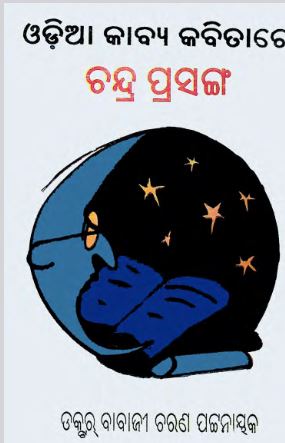In the heartfelt corridors of Odia literature, the moon, or “Chandra,” has always occupied a celestial space, weaving itself into the fabric of poetry with its enchanting light and ethereal beauty. Babaji Charan Patnaik’s 1999 essay, “Odia Kabya Kabitare Chandra Prasanga,” presents a compelling analysis of how the moon has been portrayed in Odia poetry, offering readers a profound understanding of its symbolic significance and its emotional resonance.
Patnaik’s essay delves into the aesthetic richness of Odia poetry, emphasizing how the moon has been a perpetual muse for poets. Odia poets have often drawn upon the image of the moon to evoke a sense of tranquility, yearning, and poetic splendor. Patnaik meticulously cites examples from classical to contemporary poets, illustrating the versatile roles the moon plays across different poetic compositions.
The essay begins with an exploration of classical Odia poetry, prominently highlighting the works of poets like Upendra Bhanja and Kavisurya Baladev Rath. These literary maestros, according to Patnaik, masterfully utilized the celestial body to symbolize love, beauty, and the ephemeral nature of life. For instance, in Kavisurya’s “Kichaka Vadha,” the moon is not just a passive object of beauty but a silent witness to the tumultuous events unfolding beneath its gaze.
As readers traverse through Patnaik’s essay, it’s clear that the moon’s portrayal is not monolithic. The moon manifests itself as a multifaceted symbol in Odia poetry. On one hand, it represents romance and divine beauty, casting a spell on the readers with its glow. On the other hand, it often mirrors the melancholy and loneliness that plague human existence. Poets like Gangadhar Meher and Madhusudan Rao, Patnaik points out, have adeptly used the moon to reflect inner turmoil and unfulfilled longing.
For instance, in Meher’s “Padmini” (The Lotus), the moonlight enhances the mystical ambiance around the titular character, encapsulating the tenderness of romantic admiration. In contrast, in Madhusudan Rao’s “Sadhaba Jhia,” the waning moon symbolizes the protagonist’s fading hopes, offering a stark portrayal of sorrow.
Fast-forward to modern Odia poetry, where Patnaik explores the innovative ways contemporary poets have adapted the symbolism of the moon to reflect societal changes and personal introspection. In the labyrinth of modernity and existential inquiry, the moon still retains its allure while adapting to new poetic forms and themes. Poets like Ramakanta Rath and Sitakanta Mahapatra use the moon as a bridge between the past and present, tradition and change, serenity and chaos.
In Rath’s “Sri Radha,” the moon’s imagery intertwines with the spiritual and metaphysical quest of individuals, while Mahapatra’s works often depict the moon in a manner that questions existential dilemmas, reflecting the fragmented psyche of modern man.
Babaji Charan Patnaik’s essay, “Odia Kabya Kabitare Chandra Prasanga,” is a testament to the moon’s enduring legacy in Odia poetry. By meticulously analyzing the diverse descriptions and significances attributed to the moon, Patnaik not only pays homage to the brilliance of Odia poets but also invites readers to appreciate the moon’s perennial charm and its profound emotional resonance. This exploration reinforces the notion that amidst the changing landscapes of literature and society, the moon remains an immutable symbol of beauty, contemplation, and poetic inspiration.
Books Info
| Books name | Odia Kabya Kabitare Chandra Prasanga/ଓଡିଆ କାବ୍ୟ କବିତାରେ ଚନ୍ଦ୍ର ପ୍ରସଙ୍ଗ |
| Author | Babaji Charan Patnaik |
| No Of pages | 344 |
| Publisher | Arjya Prakashana |
| Publication | 1999 |
| Printed At | Sri Jagannatha Laminator |
| Distributor | NA |

